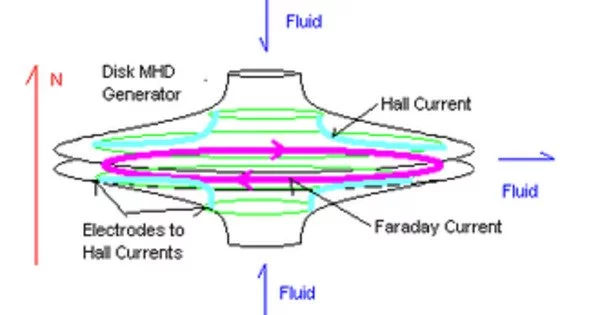A magnetohydrodynamic generator (MHD generator) is a magnetohydrodynamic converter that converts thermal and kinetic energy into electricity directly. It is a device that uses magnetohydrodynamic principles to convert the energy of a flowing electrically conductive fluid, such as plasma or ionized gas, directly into electrical energy. To generate electric current, an MHD generator, like a conventional generator, moves a conductor through a magnetic field. The moving conductor in the MHD generator is a hot conductive ionized gas (a plasma). The mechanical dynamo, on the other hand, accomplishes this through the motion of mechanical devices. It is based on Faraday’s law of electromagnetic induction.
The interaction of a fluid and a magnetic field is the fundamental principle underlying an MHD generator. The Lorentz force is experienced by an electrically conductive fluid moving through a magnetic field. This force moves the fluid and produces an electric current that is perpendicular to both the fluid flow and the magnetic field.
The fluid in an MHD generator is typically a high-temperature plasma produced by combusting a fuel such as natural gas or coal. The plasma is forced through a channel with a strong magnetic field. The Lorentz force causes the electrons in the plasma to move as it flows through the channel, creating a current. The system’s current can be extracted, resulting in the generation of electrical power.
MHD generators differ from traditional electric generators in that they do not use moving parts (such as a turbine) to limit the maximum temperature. As a result, they have the highest theoretical thermodynamic efficiency of any known electrical generation method. MHD has been extensively developed as a topping cycle to improve electric generation efficiency, particularly when burning coal or natural gas. The hot exhaust gas from an MHD generator can heat a steam power plant’s boilers, increasing overall efficiency.
MHD generators have a number of advantages, including high efficiency and the ability to convert thermal energy directly into electrical energy without the use of mechanical moving parts. However, there are difficulties associated with their practical implementation, such as the requirement for high temperatures, material erosion due to the harsh plasma environment, and the complexity of the magnetic field-design.
While MHD generators have been extensively researched and tested, they have not been widely adopted for large-scale power generation due to the technical challenges and the availability of other more economical and efficient technologies such as gas turbines and steam turbines. Nonetheless, MHD remains an active area of research and development for specialized applications and in fusion research.
















